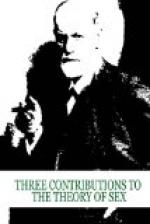It does not seem to me unjustified to fix by name the distinction in the nature of these pleasures, the one through the excitation of the erogenous zones, and the other through the discharge of the sexual substance. In contradistinction to the end-pleasure, or pleasure of gratification of sexual activity, we can properly designate the first as fore-pleasure. The fore-pleasure is then the same as that furnished by the infantile sexual impulse, though on a reduced scale; while the end-pleasure is new and is probably connected with determinations which first appear at puberty. The formula for the new function of the erogenous zones reads as follows: they are utilized for the purpose of making possible the production of the greater pleasure of gratification by means of the fore-pleasure which is gained from them as in infantile life.
I have recently been able to elucidate another example from a quite different realm of the psychic life, in which likewise a greater feeling of pleasure is achieved by means of a lesser feeling of pleasure which thereby acts as an alluring premium. We had there also the opportunity of entering more deeply into the nature of pleasure.[2]
Dangers of the Fore-pleasure.—However the connection of fore-pleasure with the infantile life is strengthened by the pathogenic role which may devolve upon it. In the mechanism through which the fore-pleasure is expressed there exists an obvious danger to the attainment of the normal sexual aim. This occurs if it happens that there is too much fore-pleasure and too little tension in any part of the preparatory sexual process. The motive power for the further continuation of the sexual process then escapes, the whole road becomes shortened, and the preparatory action in question takes the place of the normal sexual aim. Experience shows that such a hurtful condition is determined by the fact that the erogenous zone concerned or the corresponding partial impulse has already contributed an unusual amount of pleasure in infantile life. If other factors favoring fixation are added a compulsion readily results for the later life which prevents the fore-pleasure from arranging itself into a new combination. Indeed, the mechanism of many perversions is of such a nature; they merely represent a lingering at a preparatory act of the sexual process.
The failure of the function of the sexual mechanism through the fault of the fore-pleasure is generally avoided if the primacy of the genital zones has also already been sketched out in infantile life. The preparations of the second half of childhood (from the eighth year to puberty) really seem to favor this. During these years the genital zones behave almost as at the age of maturity; they are the seat of exciting sensations and of preparatory changes if any kind of pleasure is experienced through the gratification of other erogenous zones; although this effect remains aimless, i.e., it contributes nothing towards




